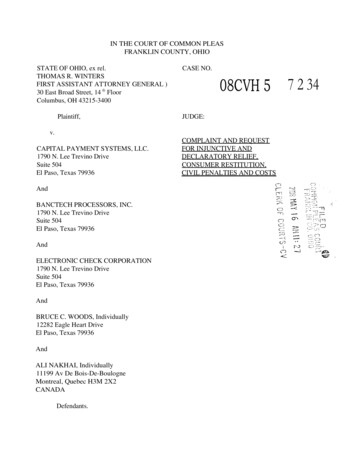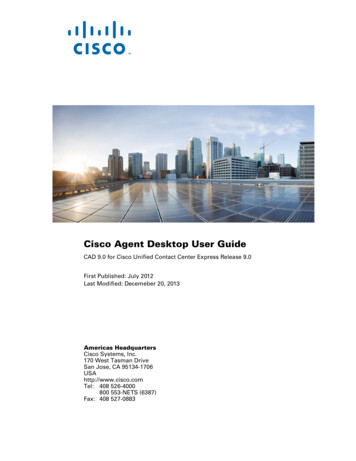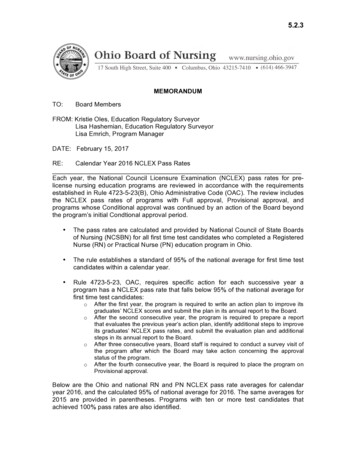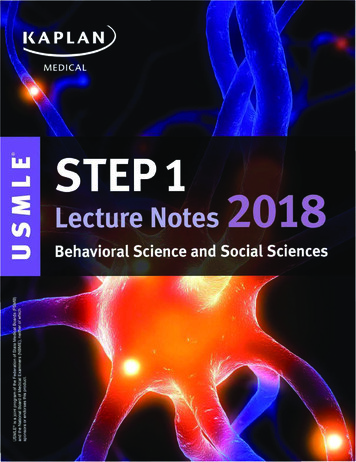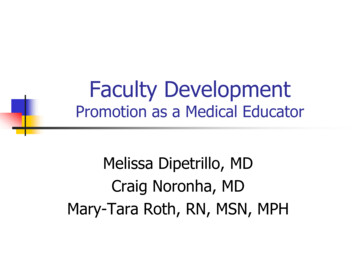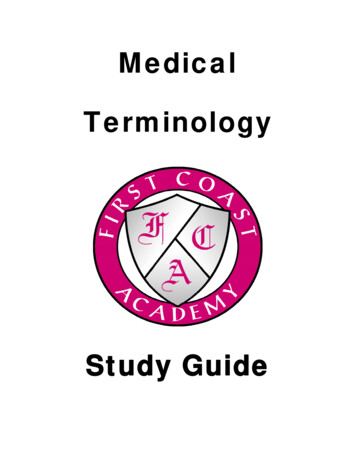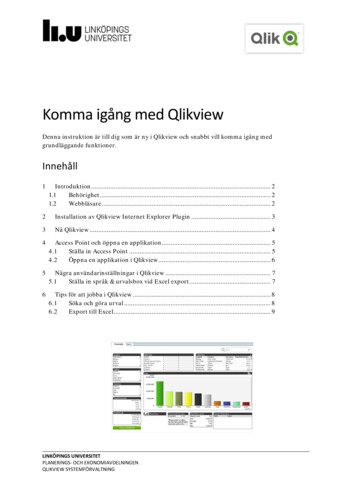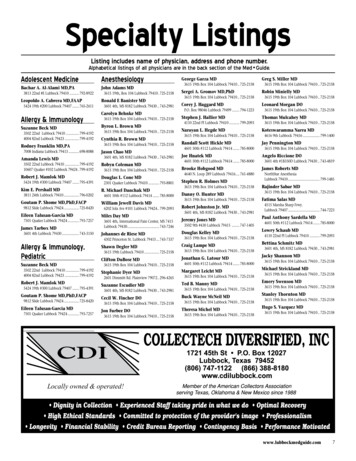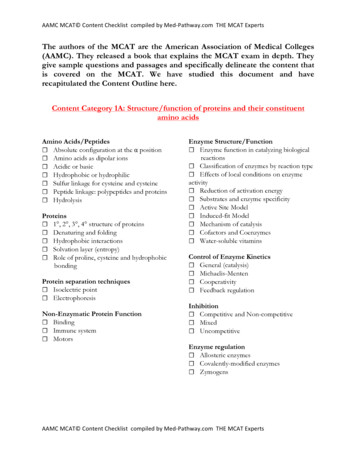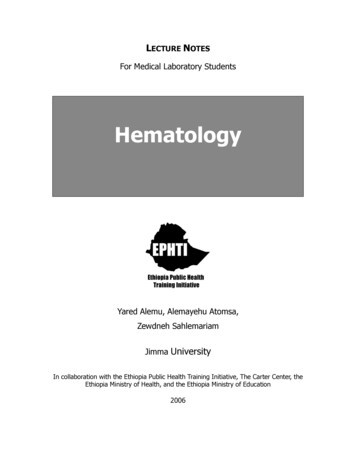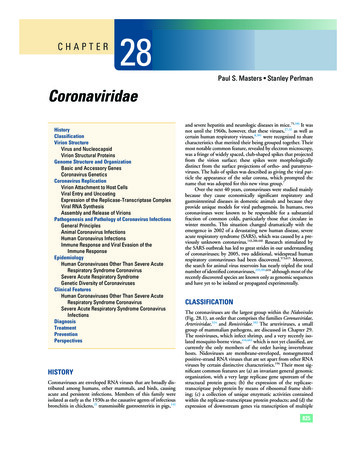
Transcription
YOUR REPORTFROM THE STATE MEDICAL BOARD OF OHIOSUMMER 2001The State Medical BoardPresidentAnant R. Bhati, M.D.CincinnatiVice PresidentPitambar Somani, M.D., Ph.D.ColumbusSecretaryAnand G. Garg, M.D., Ph.D.AvonSupervising MemberRaymond J. AlbertAmandaRonald C. Agresta, M.D.SteubenvilleR. Gregory Browning, Ph.D.ColumbusDavid S. Buchan, D.P.M.ColumbusCarol Lynn Egner, M.D.CincinnatiA WORD FROM THE PRESIDENTThis is my inaugural report to you, as I was honored to be elected by mycolleagues on the Board to serve as President during 2001. The Medical Boardhas an ambitious agenda for the year. Defining the scope of functions thatmay be safely delegated to non-physician extenders and setting practiceguidelines for office-based surgery are two issues being studied by Boardcommittees. We plan to promulgate administrative rules on both topics laterthis year.I’m pleased to report that Governor Bob Taft reappointed Anand G.Garg, M.D., to serve another five year term on the Medical Board. As theBoard’s Secretary, Dr. Garg works with Supervising Member Raymond J.Albert to determine the disposition of the over 2500 complaints filed with ouroffice each year. Their efforts contribute to the Ohio Board’s status as a leaderamong licensing authorities across the country.On the national level, Board member Ronald C. Agresta, M.D., was selectedto serve as President-Elect of the Federation of State Medical Boards at theFederation’s annual meeting held April 19-21, 2001 in Atlanta, Georgia. Inthis position, he is poised to become President of the Federation in 2002—thefirst time an Ohioan has led this internationally recognized organization since1981. Pitambar (Peter) Somani, M.D., was elected at the Atlanta meetingto a one year term on the Federation’s Nominating Committee. Ray Q.Bumgarner, our former Executive Director, was the receipient of theDistinguished Service Award, the Federation’s highest honor. The awardrecognizes outstanding service and leadership to the Federation and to thefield of medical licensure and discipline.Anquenette SloanColumbusAnant R. Bhati, MD, PresidentAnita M. Steinbergh, D.O.WestervilleCharles D. Stienecker, M.D.WapakonetaLance Talmage, M.D.ToledoExecutive DirectorThomas A. Dilling, J.D.Inside YOUR REPORTFrom the Secretary & Supervising Member . 2Licensure of Chemically Impaired Resident Physicians . 3Approved Treatment Providers . 4Healthcare Fraud and Abuse . 5AMA Health Literacy Self-Study Program . 7Free CME from Ohio Department of Health . 7Statehouse Summary . 8New Options for Allopathic CME. 11OSMB Disciplinary Actions . 12Pain Rules Survey Results . 22
From the Secretary& Supervising Memberby Anand G. Garg, M.D., Ph.D., Secretaryand Raymond J. Albert, Supervising MemberLast year, the number of disciplinary actionstaken against Medical Board licensees reached anew high: 166 sanctions were imposed, rangingfrom reprimand to permanent license revocation.Board members and staff who speak toprofessional organizations, hospital groups andstudents throughout the state are oftenquestioned about the steady rise in Medical Boarddisciplinary actions over the past decade. “Arethere really more problem doctors than there usedto be?” they want to know. What do the numbersreally tell us?From our vantage point, with years of regulatoryexperience between us, we don’t see an increasein the number of problem practitioners so muchas we do an improvement in the Board’s abilityto identify and deal with practitioners who areheaded for or are already immersed in trouble.This is particularly true with respect to impairedpractitioners. If you look more closely at ourdisciplinary statistics, you’ll find that 28% of theBoard’s actions in 2000 were based on drug oralcohol impairment. Most of those sanctionsinclude suspension of the professional licensepending appropriate treatment through a Boardapproved provider (for a current provider listing,see page 4) and verification of the licensee’s fitnessto resume practice, followed by extensiveprobationary monitoring by the Board and itsstaff. Currently, about 160 impaired practitionersare being monitored. While we know that theBoard’s strict oversight is often the subject ofderisive discussion at support group meetings,we are heartened by those probationers who,at the end of their stint with us, credit theBoard’s intervention and scrutiny with savingtheir careers.The Board has long been on record as recognizingaddiction as a disease. Thus, we will work withan impaired practitioner to support his or hersuccessful recovery and return to practice,Page 2provided that the practitioner has not engagedin acts that result in a criminal conviction or thatmight have an adverse impact on others. Ohiolaw also recognizes addiction as a treatabledisease, providing a one-time alternative routeto recovery for those who would prefer to avoidthe Medical Board altogether. This “one-biterule,” adopted as statute by the Ohio GeneralAssembly in 1987, permits licensees who becomedrug or alcohol impaired to avoid being reportedto the Board if they comply with recommendedtreatment by a Board-approved provider, commitno other reportable violations and maintainsobriety.To every rule, of course, there is an exception.The Board has never read the “one-bite rule” asapplying in the case of a new licensure applicant.An applicant who has received treatment forchemical dependency must disclose that fact onthe application, and will generally receive a licenseonly with probationary terms unless he or she isable to document five years of continuous sobrietyat the time of application.Since the implementation of the mandatorytraining certificate law in 1999, applicants for newtraining certificates, like full licensure applicants,have been required to disclose any diagnosis ofor treatment for chemical dependency. Whilethese physicians have been permitted to refrainfrom disclosing a history of chemical dependency(with no relapses) when they renew their trainingcertificates, the Board has treated them like newlicensure applicants—requiring full disclosure ofchemical dependency diagnoses and treatment—when they elect to trade in their trainingcertificates for full licenses. Recognizing that thesafeguards underlying the “one bite rule” wouldstill be present in those situations, the Boarddecided to extend those benefits to thesephysicians at its February 2001 meeting byadopting the position statement on page 3.The regulatory process is a dynamic one. As aBoard, we continually strive to improve ourprocesses and develop new approaches to betterserve the interests of the public and our licensees.YOUR REPORT/Summer 2001
STATE MEDICAL BOARD OF OHIO - POLICY STATEMENTLICENSURE OFCHEMICALLY IMPAIRED RESIDENT PHYSICIANSFebruary 14, 2001A physician licensed by the State Medical Board who suffers from impairment of abilityto practice according to acceptable and prevailing standards of care because of habitualor excessive use or abuse of drugs, alcohol, or other substances that impair ability topractice is in violation of Section 4731.22(B)(26), Ohio Revised Code, and subject toBoard disciplinary action. Any Board licensee having knowledge of such a violation isrequired by Section 4731.224(B) to report that information to the Board. In 1987,however, the Ohio General Assembly carved out a one time “one bite” exception,whereby an impaired physician may escape Board intervention, and the physician’scolleagues may be excused from reporting the physician’s impairment, so long as thephysician has completed treatment with a Board approved treatment provider andmaintained uninterrupted sobriety, and violated no other provisions of the Ohio MedicalPractice Act. In addition, the physician must adhere to all other statutory requirements.The One Bite Rule is codified in Sections 4731.22, 4731.224 and 4731.25, Ohio RevisedCode, and Rules 4731-15-01, 4731-16-04, 4731-16-07, and 4731-16-13, Ohio AdministrativeCode.The State Medical Board recognizes that resident physicians practicing under trainingcertificates are entitled to the protection of the One Bite Rule to the same extent asare fully licensed physicians. Both fully licensed physicians and residents practicingunder training certificates are excused from reporting their impairment when renewingtheir certificates so long as they continue to adhere to the requirements of the statutesand rules. Physicians seeking new Ohio licensure, however, have never been granted“one bite”, and are expected to report their status in applying for licensure. The Boardwill generally require some period of probation as a contingency to licensure if anapplicant has been impaired and is unable to document at least five years ofuninterrupted sobriety at the time of application.Physicians practicing under training certificates frequently decide to apply for fullOhio licensure after a year or two of residency training. Although these physicians doreceive new “full” licenses, the State Medical Board does not view them as new licensureapplicants for purposes of the One Bite Rule. A physician who enters treatment forchemical dependency while in residency under a training certificate need not reporthis or her impairment when applying for full licensure so long as the physician continuesto qualify for the one bite exception by completing treatment and complying withaftercare requirements. If the physician is required to respond in the affirmative toany of the other “Additional Information” questions on the application (e.g., the physicianwas placed on probation by his or her postgraduate training program) the Board willgenerally license the physician without restrictions or probationary terms ifinvestigation reveals that the problem requiring the affirmative answer would not haveoccurred but for the physician’s impairment.uYOUR REPORT/Summer 2001Page 3
APPROVED TREATMENT PROVIDERSChemical dependency treatment providers are approved by the Medical Boardpursuant to Section 4731.25, O.RC. The following list is current as of May 2001.See www.state.oh.us/med/ for updates.*Addiction Programs ofMahoning County2516 Market StreetYoungstown, OH 44507(330) 747-2614Bethesda HospitalAlcohol & Treatment Pgm619 Oak StreetCincinnati, OH 45206(513) 569-6020Brighton Hospital12861 East Grand RiverBrighton, MI 48116-8596(810) 227-1211*Cleveland Clinic9500 Euclid Ave.Cleveland, OH 44195-5189(216) 444-2970*Comprehensive AddictionService Systems (COMPASS)2465 Collingwood Blvd.Toledo, OH 43620(419) 241-8827*Crossroads CounselingServices, Inc.255 W. Main St., P.O. Box 118St.Clairsville, OH 43950(740) 695-9447Edwin Shaw Hospitalfor Rehabilitation1621 Flickinger RoadAkron, Ohio 44312-4495(330)784-1271*Glenbeigh Health Sources2863 St. Rt. 45P.O. Box 298Rock Creek, OH 44084-0298(440) 563-3400Page 4Greene Hall ChemicalDependency ServicesGreene Memorial Hospital1141 N. Monroe Dr.Xenia, OH 45385(937) 372-8011 x 5442;(937) 429-3360Marworth Treatment CenterLily Lake RoadWaverly, PA 18471(800) 442-7722*Maryhaven1791 Alum Creek DriveColumbus, OH 43207(614) 445-8131Neil Kennedy RecoveryClinic2151 Rush Blvd.Youngstown, OH 44507(800) 228-8287Shepherd Hill Hospital200 Messimer DrivePO Box 1067Newark, OH 43058-1067(740) 348-4870Sierra Tucson39580 N. Lago Del Oro Pkwy.Tucson, AZ 85739(520) 624-4000(800) 624-5858St. Thomas Medical CenterSumma Health444 North Main St.Akron, OH 44310-3178(330) 379-5906*Talbert House2600 Victory ParkwayCincinnati, OH 45206(513) 751-8600Parkside BehavioralHealthcare, Inc.349 Olde Ridenour Rd.Columbus, OH 43230(614) 471-2552Talbot-Marsh RecoveryCampus5448 Yorktowne Dr.Atlanta, GA 30349(404) 994-0185;(800) 445-4232Rogers Memorial HospitalHerrington Recovery Center34700 Valley RoadOconomowoc, WI 53066(262) 646-3526 x240The Toledo Hospital2142 North Cove Blvd.Toledo, OH 43606(419) 471-2300inpatient: (419) 471-2351Rosary Serenity Centerat St. Vincent Charity Hospital2351 E. 22nd St.Cleveland, OH 44115(216) 363-2580West Michigan AddictionConsultants, P.C.3001 Fuller Ave., N.E.Grand Rapids, MI 49505(800) 253-7700*Approved treatment providers with the ability to adjust fees on a sliding scaleYOUR REPORT/Summer 2001
EDITORIALHealthcare Fraud & Abuseby Charles Stienecker, M.D., MemberMaterial for the following article was extracted from a presentation byRobert J. Benvenuti III, J.D., MPA, to the University of Kentucky FamilyMedicine Review (November 2000), and is being used with thepermission of the author.With increasing frequency, theU.S. Department of Justicescrutinizes physicians forMedicare fraud and abuse.Various sources have estimatedthe total annual cost related tofraud and abuse in the healthcare industry to be 90 billiondollars, or 10% of each dollarspent on health care. According to the Department ofHealth and Human Services,improper payments to physicians total 5.9 billion dollarsannually. As a result, policymakers, regulators, and lawenforcement agencies havebeen taking a closer look at thepractices of health careprofessionals. Since 1996, forexample, addressing issues ofmedical fraud and abuse hasbecome the number twopriority of the United StatesDepartment of Justice. TheHealth Insurance Portabilityand Accountability Act of 1996(HIPPA) authorized massiveincreases in funding for theinvestigation and prosecutionof fraud and abuse. Further,HIPPA expanded the scope offraud and abuse statutes andfacilitated coordination ofinvestigative efforts amongagencies at all levels ofgovernment and createdYOUR REPORT/Summer 2001jurisdictional scope to reachfraud committed againstprivate payers, i.e., insurancecompanies and your privatepatients.There are eight basic sources ofstatutes and prohibitionsencompassing both criminaland administrative law:1. Theft, bribery or embezzlement related to healthcare2. Mail/wire fraud3. False statements or representations, includingadvertising4. Specific health care fraud,i.e., HIPPA5. The RICO, or RacketeerInfluenced and CorruptOrganizations Act, aimed atpatterned misconduct6. The False Claims Act7. Anti-kickback statutes, and8. Anti-referral laws or StarkI and IIThe lawyers may recognizefraud and abuse in technicalterms as defined in thesestatutes, but for our purposes,a more general statement maybe more helpful. In general,FRAUD is any act, omission,or concealment, calculated todeceive, or “making false statements or representations ofmaterial facts in order to obtainsome benefit or payment forwhich no entitlement wouldotherwise exist.” There is aburden to show that the actwas based on the intent of thephysician to engage in illegalbehavior; that is, that “beyonda reasonable doubt” the doctor“actedknowinglyandwillfully.”ABUSE, on the other hand,broadly defined, is anyexcessive, improper or harmfulact “that either directly orindirectly results in unnecessary cost.” A finding ofabuse does not depend on aphysician’s intent; it requiresonly that “a preponderance ofthe evidence” suggests thedoctor was “acting withknowledge, or in deliberateignorance or with recklessdisregard of the truth or falsityof certain information.” Thatyou “knew or should haveknown” is enough to findagainst you; specific intent todefraud is not required. Anastounding array of actionscan potentially lead to aninvestigation of your practice.The following list points out thebreadth of vulnerability:1. Billing for services orsupplies that were notprovided2. Misrepresenting the natureof services provided3. Misrepresenting the agentthat provided care4. Billing for unnecessaryservices5. Billing for unallowable cost6. Failure to follow doc-Page 5
Fraud & Abuse (cont.)umentation guidelines or not having sufficient documentation to support a claim forreimbursement7.Beneficiary inducement (e.g., waiving copays)8.Billing for services provided by unqualifiedor unlicensed clinical personnel9.Knowingly billing for inadequate or substandard care10. Making false or fraudulent statements orrepresentations related to the delivery ofhealth care11. Failing to return monies wrongfullyobtained12. Violation of participation agreements13. Illegal remuneration or self-referrals14. Faulty or otherwise inadequate businesssystemsWho is involved in enforcing these new statutes?The list is long and includes the Department ofJustice (U.S. Attorneys and the FBI), theDepartment of Health and Human Servicesthrough the Office of the Inspector General, andalmost every other federal agency. At the statelevel, fraud control units and licensing boards aresupplemented by state-designated Medicarecarriers, their intermediaries, and privateinsurance companies. At the bottom of thisfeeding chain are the private bounty hunters forpersonal gain; qui tam relators, whistleblowergovernment contractors; and your former andcurrent patients and employees. There is, as youcan see, a rather daunting group of watchdogs.Physicians face an alarming array of thesepotholes. With so many acts constituting fraudand abuse, it is helpful to note what behaviordoes not rise to the level of fraud or abuse.Singular mistakes and innocent errors are notlikely to become a problem unless frequentrepetition of a pattern of conduct gives rise toallegations that a physician “should have known”that his/her behavior was questionable.Similarly, good faith interpretations and goodfaith reliance on professional advice, if it isreasonable and documented, are defensible. Theold adage applies here: “You can’t get somethingPage 6for nothing”.or keep it.very long.anymore.Free advice might well be worth what you payfor it; competent legal and financial counsel canbe invaluable.The best remedies for these vulnerabilities arecorporate compliance programs. These programsprovide the best defense against allegations basedupon a physician’s intent to defraud, and the bestsupport for an argument for mitigation of aphysician’s culpability based on his/her professionof having acted in good faith. They are meansby which an entity, including a doctor’scorporation, may take affirmative steps to preventand detect illegal, unethical or abusive conductwithin an organization.There are a number of additional reasons that aphysician would want to maintain an effectivecompliance program. First, it is the right thingto do and it helps to maintain the trust of thecommunity. It is an opportunity to self-correctand to reduce the likelihood of wrongful conductand innocent mistakes. It will reduce thelikelihood of persons in your practice being foundto have acted with criminal intent or recklessdisregard for the law and, and it will help younegotiate with the government from a position ofstrength to avoid mandated integrity agreements.In sum, corporate compliance programs help tomaintain the financial stability of your practiceand protect your license and your practice fromjeopardy.There are seven basic elements to an effectivephysician practice compliance plan:1.2.3.4.5.One person must be designated oversightresponsibility. This person is usually thedoctor, but the task can be delegated to anoffice manager.Develop a code of conduct, policies andprocedures that express, in writing, thecommitment to compliance.Establish a simple reporting procedure.Establish documented education and trainingprograms, focusing on the code, policies, andprocedures, for all corporate personnel.Establish monitoring and auditing proceduresto regularly review the business and clinicalYOUR REPORT/Summer 2001
activities of the practice.Develop a response, correction andprevention policy.7. Develop a statement of enforcementstandards and a schedule of disciplinaryaction engaging in fraudulent or abusivepractices or for failure to report incidents ofsuch behavior. Conversely, one may alsocon
Neil Kennedy Recovery Clinic 2151 Rush Blvd. Youngstown, OH 44507 (800) 228-8287 Parkside Behavioral Healthcare, Inc. 349 Olde Ridenour Rd. Columbus, OH 43230 (614) 471-2552 Rogers Memorial Hospital Herrington Recovery Center 34700 Valley Road Oconomowoc, WI 53066 (262) 646-3526 x240 Rosary Serenity C
